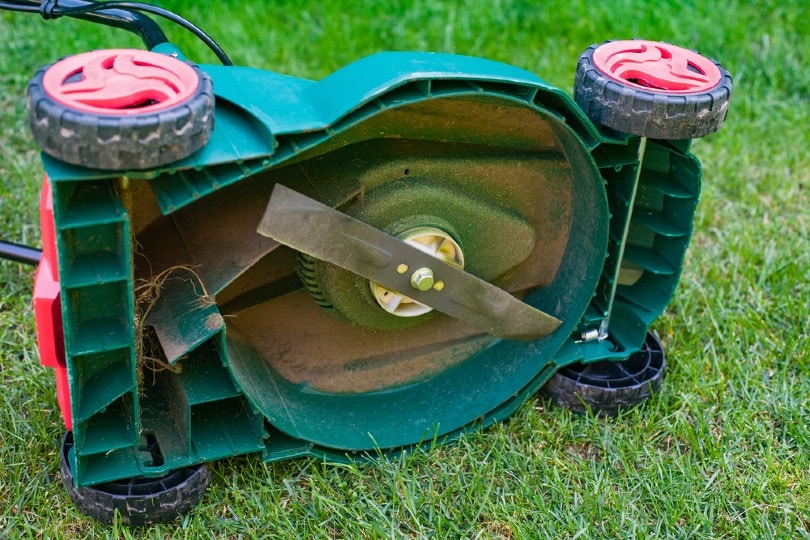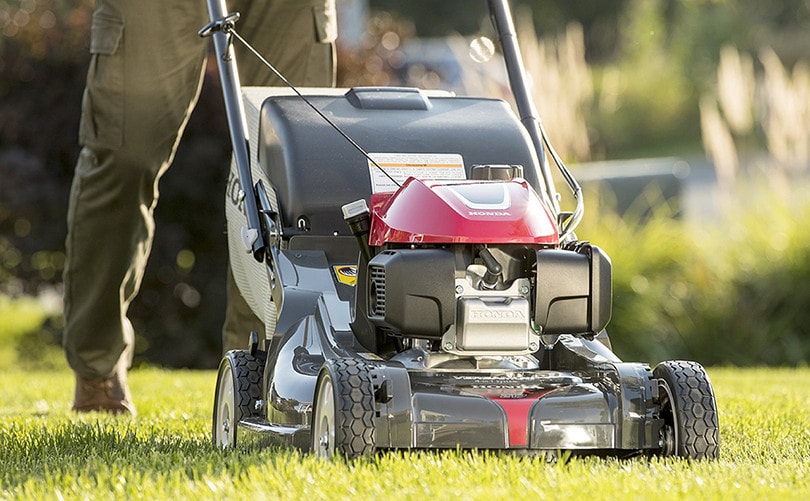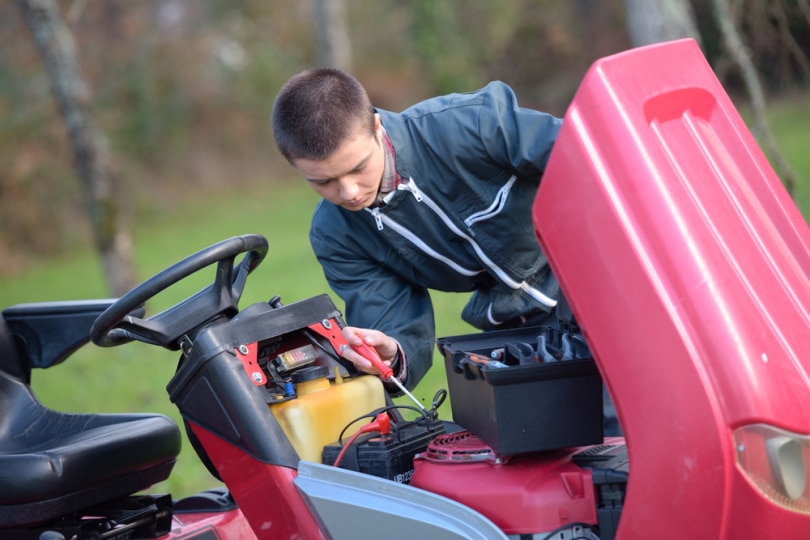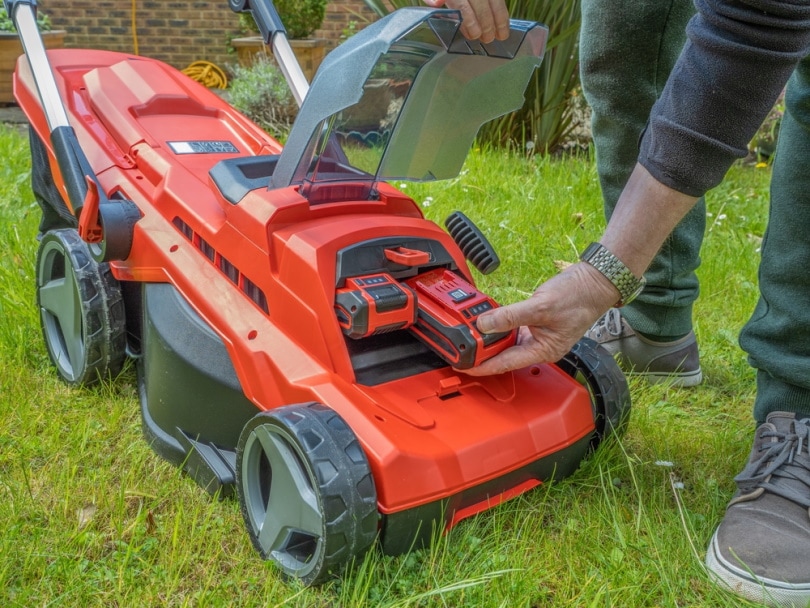Why Won’t My Battery-Powered Lawn Mower Start? 6 Reasons & Fixes
-

- Last updated:

Battery-powered lawn mowers are much easier to maintain and repair than standard lawn mowers. Nevertheless, problems can still arise. Once you detect a problem, it is essential to locate it and know how to fix it properly. You can fix some issues on your own, while others must be handled by a professional. Whatever the problem may be, you must learn to recognize it in time to prevent further damage to your lawn mower.
If you find your battery-powered lawn mower refuses to start—and you don’t know the reason behind it—read this article to learn all the possible causes and how to solve them.
The 6 Reasons Why Your Battery-Powered Lawn Mower Won’t Start
1. Issues with the battery
The first thing you should do when your lawn mower doesn’t start is to check the battery—the most common problems will be battery-related. Due to extreme weather exposure, batteries tend to go drain, fail, or even die. Check if you installed the battery correctly and that it has sufficient power. If the battery is fully charged, it would be wise to inspect it and look for signs of visual damage. The battery needs to be dry, so if you notice it is damp, that may have led to a short-circuit and overheated the battery.
Solve: If you begin to notice your battery won’t charge fully, overheats frequently, or can’t hold a charge for a longer time, it might be time to replace the battery.

2. Bad connections
To ensure proper charging of the battery, you must make sure that the connection between the battery charger, charging port, and the wall outlet is correctly set up. Inspect whether the contact between the charger and the outlet is securely in place. It is best to use a standard 120V outlet and a plug that suits the outlet type.
Solve: When you start charging your battery, ensure the contacts on the battery pack are in place. Most chargers will include a light indicator that will show you the precise battery level and when the battery is charging.
Furthermore, inspect the charger for any visible damage. You can check the charger with a volt meter to see if it supplies energy. If not, you will need to replace the battery charger.
3. Issues with the start switch and motor
Multiple issues can potentially cause your lawn mower to refuse to start. Try checking for any signs of clogs or collected debris. If you are not getting any responses from the battery even after checking all other components, there is probably an issue with the start switch.
Solve: If you have an issue with the start switch or suspect it might be the problem behind your lawn mower not starting, you’ll probably have to replace it. The good news is that replacing a start switch is much cheaper than replacing a motor, and you could do it by yourself or simply call a technician.
If the lawn mower doesn’t start even after replacing the start switch, you have to take your mower to the repair shop as the motor might need repairing.

4. Damaged components
A battery-powered lawn mower is just the same as a standard lawn mower regarding working parts and components and their wear and tear. You can replace many elements on a battery-powered lawn mower as a part of regular maintenance, such as batteries, battery chargers, power cords, or blades. Other than these smaller and more affordable components, there are parts on a lawn mower that are more problematic to replace and cost a lot more. Features such as the start switch and the motor are much more challenging to replace and to do so, you will probably need to count the costs of a repair shop as well.
Solve: If you find damage in a more complex component of a battery-powered lawn mower, it would be best to take it to the repair shop and let the mechanic evaluate the amount of the damage. The damage might be too challenging and expensive and not worth replacing.
5. Loose wires
Your battery lawn mower is a complex machine even though it doesn’t run on gas. It has a lot of electrical wires that run through the mower. If your lawn mower doesn’t start, a possible reason might be a pinched, damaged, or loose wire. Using a volt meter, you can begin by inspecting your battery mower for any damaged wires. If you have a push mower, check the cables where the handle folds since they can quickly get pinched when you hold them.
Solve: Before doing any repairs on your own, check to see if your lawn mower has a warranty and whether it still covers the mower. If you don’t have a warranty on your lawn mower, you can proceed to repair any potential damage. First, remove the battery, and locate the loose wires. You can easily repair the loose connections with a wire nut.

6. Clogged vents
Battery-powered lawn mowers are similar to gas-fueled lawn mowers when it comes to vents that help cool the engine. The vents maintain an optimal temperature in the engine during use and prevent it from overheating. If your vents become clogged, your engine is more likely to overheat, preventing the lawn mower from starting.
Solve: When cleaning the vents, you must be extremely careful not to damage the engine. It is best to use a dry cloth and remove any debris or particles preventing the vent from running correctly. If you cannot unclog the vent this way, you can use a tool such as a compressed air can. Stay away from using any liquids, as they can permanently damage your engine and motor’s lubrication.
How to Properly Maintain a Battery-Powered Lawn Mower
It is essential to know how to maintain your mower so it will have a long-lasting life and to prevent your lawn mower from having any issues.

Regularly clean your lawn mower
It would be best to clean your lawn mower after every use. Dirt, debris, and grass clippings can proceed to collect on the mower’s blade, causing it to clog, so it is best to regularly clean your mower to reduce the risk of any damage.
Keep your lawn mower in a dry place
Water and moisture can seriously damage a battery-powered lawn mower, as certain components can begin to rust. Make sure never to leave your lawn mower in the rain. Instead, store it in a safe and dry place.

Properly store the cord and the battery
Remove cords and batteries after every use and store them separately from the lawn mower. This way, you will keep the cords safe, away from blades or wheels, and you can charge the battery for the next use. Remember never to leave the battery on the charger for too long or to let it drain completely.
 Final Thoughts
Final Thoughts
Hopefully, this article will help you determine the exact problem in your lawn mower and what is preventing it from starting. Even though there are many possible reasons a lawn mower won’t start, with a battery-powered mower, it is much easier to locate the problem than with a gas-fueled mower.
The most common issues are not as complicated to fix, such as the battery and the charging system, although when more severe problems arise, it would be best to take your lawn mower to a mechanic.
See Also:
- Why Won’t My Lawn Mower Stay Running? 8 Possible Reasons
- 11 Reasons Your Lawn Mower Won’t Start After Sitting
Featured Image Credit: Ocskay Mark, Shutterstock
Contents

